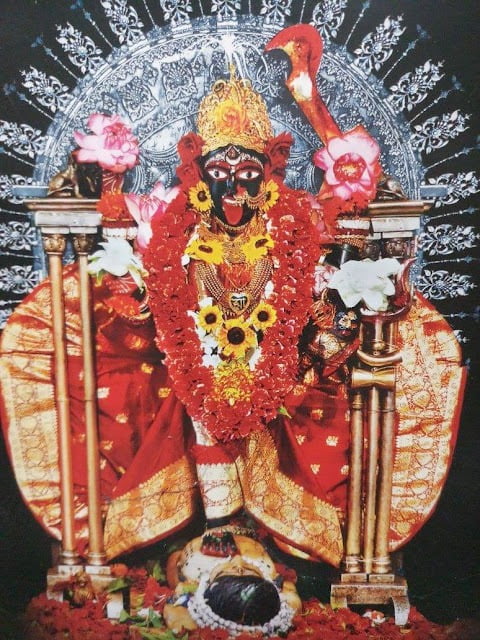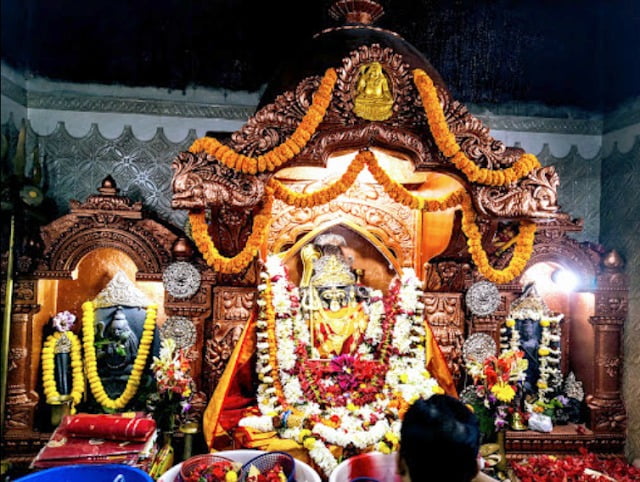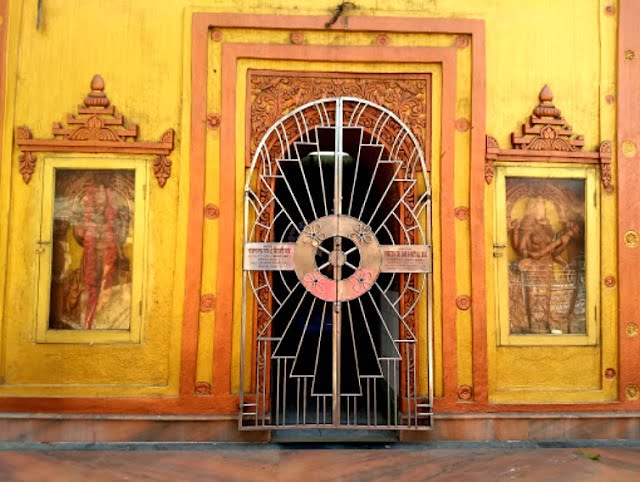Vibhash Shakti Peeth | Kapalini (Bhimarupa) Shaktipeeth
Vibhash Shakti Peeth is one of the 51 Shakti Peethas, or holy sites associated with the goddess Shakti. According to legend, the left ankle of the goddess Sati fell here after she immolated herself in protest of her father’s decision to marry her to the ascetic god Shiva.

It is dedicated to the goddess Kapalini, an incarnation of Shakti. The main deity is a black stone idol of the goddess, which is said to have been found at the site by a local shepherd. The shrine also houses a shrine to the god Shiva, who is worshipped here as Sharwanand.
The Bheemakali Temple is a popular pilgrimage destination, especially during the annual Navaratri festival. The shrine is open to all visitors and is free to enter.
The significance of the Shakti Peeth lies in its association with the goddess Sati. According to Hindu mythology, Sati was the daughter of the king of the gods, Daksha. She was married to the god Shiva, who was an ascetic and lived in the Himalayas. Daksha was unhappy with Sati’s marriage and did not invite Shiva to a yagna (fire sacrifice) that he was hosting. Sati was so upset that she immolated herself in the yagna fire.
When Shiva learned of Sati’s death, he was overcome with grief. He wandered the earth in a rage, carrying Sati’s body with him. Eventually, he came to the kapalini Shaktipeeth, where he placed Sati’s body on the ground. As he did so, her left ankle fell off.
The spot where Sati’s ankle fell is now marked by the Vibhash Shakti Peeth temple. The shrine is a popular pilgrimage destination for Hindus, who believe that it can grant them moksha (liberation from the cycle of rebirth).
Read More>> Lalita Devi Temple Naimisharanya
Contents
- 1 Miracles:
- 2 Temple Timing:
- 3 Tourist spots near to the temple:
- 4 FAQ:
- 4.0.1 What is Vibhash Shakti Peeth?
- 4.0.2 What is the significance of Vibhash Shakti Peeth?
- 4.0.3 What are the rituals performed at Vibhash Shakti Peeth?
- 4.0.4 How can I reach Vibhash Shakti Peeth?
- 4.0.5 Here are some frequently asked questions about Vibhash Shakti Peeth:
- 4.0.6 Here are some dos and don’ts for visiting Vibhash Shakti Peeth:
- 5 How to reach Vibhash Shakti Peeth:
- 6 Google Maps:
Here are some of the reasons why people visit the Vibhash Shakti Peeth:
- To seek the blessings of the goddess Shakti.
- To pray for moksha (liberation from the cycle of rebirth).
- To cure diseases or ailments.
- To fulfill a vow or to seek the goddess’s intervention in a difficult situation.
- To experience the spiritual energy of the temple.
The Kapalini Shakti Peeth is a sacred place for Hindus and is believed to be a powerful source of blessings. If you are interested in learning more about this shrine or planning a visit, I recommend doing some research online or contacting a local travel agent.
Read More>> Nainativu Nagapooshani Amman Temple

Miracles:
There are many stories of miracles that have been attributed to the Vibhash Shakti Peeth in Medinipur, India. Some of these stories include:
- A woman who was unable to conceive was miraculously able to become pregnant after praying at the shrine.
- A man who was suffering from a terminal illness was miraculously cured after bathing in the temple’s holy water.
- A group of people who were trapped in a flood were miraculously saved after praying to the goddess Mangal Chandi.
These are just a few of the many stories of miracles that have been reported at the temple. While there is no scientific evidence to support these claims, they continue to be told and retold by devotees of the goddess Mangal Chandi.
Here are some other miracles that are attributed to the temple:
- A woman who was possessed by a demon was cured after being exorcised by a priest at the temple.
- A man who was blind from birth was able to see after praying at the shrine.
- A child who was born with a physical deformity was miraculously cured after being touched by the goddess Mangal Chandi.
Whether or not these miracles are real, they continue to inspire people from all over to visit the Bhimarupa Shakti Peeth. The temple is a place of hope and faith for many, and it is believed that the goddess Mangal Chandi can grant any wish to those who pray to her with sincere devotion.
Read More>> Biraja Temple Shakti Peeth Jaipur
Here are some specific examples of miracles that have been attributed to the Vibhash Shakti Peeth:
In 2010, a woman named Anjali was unable to conceive after trying for several years. She prayed to the goddess Mangal Chandi at the shrine, and soon after she became pregnant. She gave birth to a healthy baby boy a few months later.
In 2012, a man named Suresh was diagnosed with cancer. He underwent surgery and chemotherapy, but his condition continued to deteriorate. He prayed to the goddess Mangal Chandi at the Vibhash Shakti Peeth, and soon after he began to improve. He completed his treatment and is now cancer-free.
In 2015, a group of people were trapped in a flood in the nearby village of Tamluk. They prayed to the goddess Mangal Chandi at the Kapalini Shaktipeeth, and soon after the floodwaters receded. Everyone in the group was safe and unharmed.
These are just a few examples of the many miracles that have been attributed to the Vibhash Shakti Peeth. While there is no scientific evidence to support these claims, they continue to inspire people from all over to visit the temple. The shrine is a place of hope and faith for many, and it is believed that the goddess Mangal Chandi can grant any wish to those who pray to her with sincere devotion.
Read More>> Mahamaya Shakti Peeth Amarnath
Temple Timing:
The Kapalini Shaktipeeth temple is open to the public from 6:00 AM to 9:00 PM, all year round. The shrine is busiest during the Navaratri festival, which is celebrated in September or October each year. During this time, the temple is open for 24 hours.
Here are the specific timings of the temple:
Morning: 6:00 AM to 12:00 PM
Evening: 3:00 PM to 9:00 PM
Night: 9:00 PM to 6:00 AM (during Navaratri festival only)
The temple is closed on Mondays, but it is open on all other days of the week.
Tourist spots near to the temple:
Digha Beach: Digha Beach is a popular beach resort located about 100 kilometers from the spot. The beach is known for its white sand, clear waters, and lush green surroundings.
Tamluk Rajbari Palace: Tamluk Rajbari Palace is a historical palace located in Tamluk, about 15 kilometers from temple. The palace was built in the 18th century and is now a museum.
Jhargram Palace: Jhargram Palace is a historical palace located in Jhargram, about 50 kilometers from Vibhash Shakti Peeth. The palace was built in the 19th century and is now a heritage hotel.
Medinipur Town: Medinipur Town is the district headquarters of Purba Medinipur district and is located about 20 kilometers from Vibhash Shakti Peeth. The town has a number of historical buildings, including the Medinipur Rajbari and the Medinipur Fort.
Chilkigarh Kanak-Durga Temple: Chilkigarh Kanak-Durga Temple is a Hindu shrine located in Chilkigarh, about 50 kilometers from Vibhash Shakti Peeth. It is dedicated to the goddess Durga.

FAQ:
What is Vibhash Shakti Peeth?
Vibhash Shakti Peeth is one of the 51 Shakti Peethas, sacred Hindu pilgrimage sites dedicated to the goddess Shakti. It is located in the Tamraluk village of West Bengal, India, on the banks of the Roopnarayan River.
What is the significance of Vibhash Shakti Peeth?
Vibhash Shakti Peeth is said to be the place where the left knee of Sati, the consort of Shiva, fell after she was beheaded by her father, Daksha Prajapati. The goddess is worshipped here as Kapalini, which means “she who wears a skull”.
What are the rituals performed at Vibhash Shakti Peeth?
The most important ritual performed at Vibhash Shakti Peeth is the Mahasnan, which is a bathing festival that takes place every year in July or August. During this festival, the Roopnarayan River is said to turn red with the blood of Sati.
How can I reach Vibhash Shakti Peeth?
Vibhash Shakti Peeth is located in the Tamraluk village of West Bengal, India. The nearest railway station is Tamluk, which is about 10 km away. The temple is also accessible by road.
Here are some frequently asked questions about Vibhash Shakti Peeth:
- What is the history of Vibhash Shakti Peeth?
The history of Vibhash Shakti Peeth is closely linked to the legend of Sati. According to the legend, Sati was married to Shiva, the god of destruction. Her father, Daksha Prajapati, was a devout follower of Vishnu, the god of preservation. He was offended by Shiva’s appearance and lifestyle, and he decided to hold a yagna (fire sacrifice) to which he invited all the gods and goddesses, except Shiva and Sati.
Sati was heartbroken when she learned that she had not been invited to the yagna. She disguised herself as a brahmin boy and attended the yagna. When Daksha saw Sati, he was furious and insulted her in front of everyone. Sati was so humiliated that she immolated herself in the yagna fire.
Shiva was enraged by Sati’s death. He carried her body on his shoulders and danced a wild dance of destruction. The gods were afraid that Shiva would destroy the world, so they intervened and persuaded him to lay down Sati’s body.
As Shiva danced, Sati’s body was dismembered into 51 pieces, which fell to earth at different places. These places became known as Shakti Peethas.
- What is the significance of the left knee of Sati?
The left knee of Sati is said to be the seat of her power. It is believed that those who worship the left knee of Sati will be blessed with strength, courage, and success.
- What are the benefits of visiting Vibhash Shakti Peeth?
It is believed that those who visit Vibhash Shakti Peeth will be blessed with the following:
- Moksha: Liberation from the cycle of birth and death
- Dharma: Righteousness
- Artha: Wealth
- Kama: Pleasure
- Moksha: Liberation from the cycle of birth and death
- What are the dos and don’ts for visiting Vibhash Shakti Peeth?
Here are some dos and don’ts for visiting Vibhash Shakti Peeth:
Dos:
- Dress modestly.
- Take a bath before entering the temple.
- Offer prayers to the goddess.
- Seek the blessings of the priest.
Don’ts:
- Do not speak loudly or laugh inside the temple.
- Do not eat or drink inside the temple.
- Do not touch the idols or the temple premises.
- Do not take photographs inside the temple.

How to reach Vibhash Shakti Peeth:
By Air: Nearest airport to Bheemakali Temple in Medinipur is Netaji Subhash Chandra Bose International Airport (CCU) in Kolkata. It is about 150 kilometers away from the temple.
By Train: The nearest railway station is Tamluk Junction, which is about 10 kilometers away from the shrine. From Tamluk Junction, you can take a taxi or rickshaw to the temple.
By Bus: There are several bus services that ply between Tamluk and Medinipur. You can get off at the Mahatabpur bus stop, which is about 2 kilometers from the temple. From there, you can take a rickshaw or walk to the temple.
By Car: If you are driving, you can take the NH16 highway from Kolkata. The temple is located about 160 kilometers from Kolkata.
Here are some other tips for reaching Bheemakali Temple:
- If you are traveling during the peak season (October-November), it is advisable to book your transportation in advance.
- Wear comfortable shoes as you will have to climb a few steps to reach the temple.
- Bring a bottle of water as it can get hot in the afternoon.
- Be respectful of the temple and its surroundings.
- Take some time to explore the surrounding area. There are several other temples and historical sites in the area.
